|
THIS IS CERTAIN: At 9 a.m., Wednesday, April
21, the New York World's Fair will throw open the eight gates
that guard the 646-acre enclave. The 1965 season will begin.
This 180-day run will conclude the controversial extravaganza
that shoves together carnival, education, religion, international
amity, Madison Avenue merchandising, some art, band music, popcorn,
beer and hot dogs. For the public, it is a "last-chance
saloon." Once the exhibition closes, faint hope lives that
such will be duplicated for generations -- at least not in New
York City.
When the gates closed on October 18, the piped
music was stilled, the pavilions got cocoons of plastic and plywood.
The exhibitors began to plot their moves for the 1965 edition.
Some sponsors had good reason, for Flushing Meadow Park was,
last year, a ground that seemed not hallowed, but jinxed. On
opening day, CORE pickets threatened highway stall-ins to dramatize
their school integration demands. Poetically, it rained; thousands
stood in the splatter to hear President Lyndon B. Johnson officially
open the fair. Many pavilions were not completed for the start
-- one, the Belgian Village, didn't open until August.
What dominated winter brooding was the head
count at the gate. Average daily attendance was 170,000. The
best single day was October 11, when 264,552 showed up. Before
the Fair opened, the management announced that over 28 million
tickets had been sold. Early estimates put the total two-season
attendance at 70 to 80 million. So 40 million seemed reasonable
for 1964.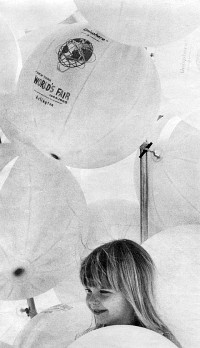
What went wrong in wonderland? First, the
Harlem riots undoubtedly affected would-be visitors to New York.
Next, throughout the season, almost every intramural bicker was
publicized. The Olympics of Progress -- the title is from World's
Fair President Robert Moses -- came up like a daily Donnybrook.
For example, there was bickering between the representatives
of Jordan and the adherents of the American-Israel Pavilion,
who differed about the intent of a Jordanian mural. Some exhibitors
complained, seemingly with bullhorns, about the high cost of
services required to maintain pavilions. One item: When an eighty-pound,
3x4-foot wooden sign blew down, it cost the British Lion Pub
$92 to have it put back; the workman's lunch was in the bill.
Other international exhibitors used their own staffs to clean
their pavilions because of the prices charged by the Allied Maintenance
Corporation, which had a monopoly. (This year, the showmen will
have nine firms to choose from.)
Shows like Dick Button's Ice-Travaganza,
Wonderworld (in the Amphitheater) and To Broadway with
Love went begging, and broke. The last two were located in
the Lake Amusement Area and all were paid-admission shows. The
Texas Pavilion folded like a campstool. Other exhibitors, isolated
from heavy pedestrian flow, realized too late that they were
dealing in an all-or-nothing business that allows for no tryouts.
Without fail, everyone's beef wound up in a fishbowl.
Moses announced that the Fair had no surplus
and needed $3.5 million to reopen. The reasons given for the
$17.5 million deficit were low attendance, loans to sinking pavilions,
high maintenance and security costs. He stated that New York
City would not be repaid the $24 million advanced to the Fair
Corporation for the permanent improvements at Flushing Meadow
Park, and he refused to open the books for detailed audits. Whereupon
five bankers on the advisory financial committee quit. Thomas
J. Deegan, Jr., chairman of the executive committee, who was
instrumental in getting Moses to be the Fair's boss, joined the
financiers' dissent. Deegan, whose firm had handled the Fair's
public relations for five years, dropped the $300,000-a-year
account. From City Hall, cries for a detailed audit of the closed
books rose from Controller Abraham D. Beame.
Exhibitors, who have poured hundred of millions
into the Fair, are split on Moses's stewardship. Many offer a
Moses reply -- "No comment" -- on his record. One calls
him "A genius. He is brilliant, a doer. Of course, you can
argue about his tactics." Another says, "If only he'd
bend a little."
Jeno Paulucci, the president of the Chun King
Corporation says, "The criticisms of the Fair's management
are stupid. Our restaurant served 5 million people, and we came
within 2 percent of our estimates. Going into the Fair is like
going into a TV show. You might wind up with 10 million -- or
20 million in the audience. What are they out there for? Advertising.
I'm just a country boy, and the idea of 30 million people seeing
our products is fine with me. It's a perfect extravaganza. We're
going to serve another 5 million this season."
"I am emotionally involved in the Fair,"
says Ralph Bugli of the Swedish Pavilion. "It is a tremendous
show, and it is the show that counts, and not what goes on in
the box office."
The show is the thing ... while the aesthetic
eyes are bloodshot from scanning the commercial aspects of this
Fair (all Fairs have had sales as their motives), the same eyes
are cleared by the Romanesque collection in the Spanish Pavilion,
the pop-art photographic visions by Robert Rauschenberg at the
New York State Pavilion, the chalky imagery of Parable,
a movie in the Protestant and Orthodox Center. The skill of the
glassblower in the West Virginia Pavilion may reassure some highbrows
that automation has not swept away everything. Actually, the
Fair spans so many opposites that in July of last year, the two
"hits" were the Pieta (by Michelangelo) and
the Mustang (by the Ford Motor Company). This disparity is the
main reason for seeing the Fair. Here is the mid-century spread
over a one-square-mile stage under an improbable proscenium.
The millions thronging to the Fair are making this age and maybe
changing it. Most fair goers don't care whether or not "Robert
Moses can play his own town" -- a tough act for anyone,
even in Kenosha. They want to see a show. At the 1965 World's
Fair, they are probably seeing the last epic of its kind.
Come opening day, the trumpet blasts of high-school
bands, the hawking of vendors and the popping of fireworks will
drown out the squeals from the box office. And as to the question,
"Will the Fair really open?" the answer is Yes.
As one industrial exhibitor put it, "Our exhibit will open
on April 21, even if we have to buy the joint. And it will stay
open for the entire season."
-
FAREWELL
TO THE FAIR
|
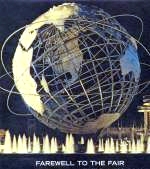
Click HERE
|
After years of planning and
construction and two seasons of operation, the 1964/1965 New
York World's Fair came to a close on October 17th, 1965. The
world had beaten a path to its door and now it was time to return
the land it had occupied to the natives. Learn of the Fair's
final days, its demolition and the post-Fair restoration of Flushing
Meadows-Corona Park. |
|
 Webmaster's note... the
story the Fair's financial difficulties, final days and demolition,
and Flushing Meadow Park's restoration, is documented at nywf64.com in the
Feature, "Farewell
to the Fair." You are invited to continue exploring
the fascinating story of the 1964-1965 New York World's Fair
there . . .
Webmaster's note... the
story the Fair's financial difficulties, final days and demolition,
and Flushing Meadow Park's restoration, is documented at nywf64.com in the
Feature, "Farewell
to the Fair." You are invited to continue exploring
the fascinating story of the 1964-1965 New York World's Fair
there . . .
|
A sea of Glide-a-Rides await the auction block
(above) shortly after the Fair closed
in 1965. A family watches the traffic glide by the the Long Island
Expressway (below) as demolition of the Fair begins.
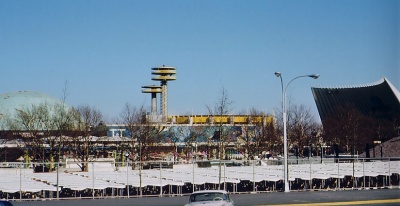 |
(above) The Kodak Pavilion, abandoned and debris
strewn, waiting for the wreckers. A Fairground street devoid of
Fairgoers shortly after the close of the Fair in 1965 (below)
-- a sad and lonely sight after six years of monumental effort
to bring the Fair to the World.
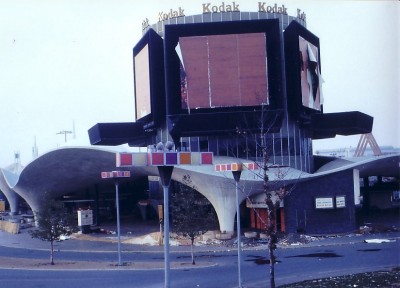 |
SOURCE: Photographs
by Max Mordecai
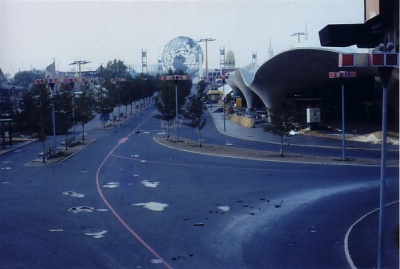 |
|
Webmaster's note... As always, there are so many people to
thank when a Feature goes up on nywf64.com. I am always grateful when people are
kind enough to contribute to a presentation. First of all, a
very big Thank You to Bradd Schiffman who took the time and patience
last year to scan in the Fair's Newsletter (FAIR NEWS)
and Progress Reports. They have been an invaluable resource in
putting together this feature. There's so much more that could
have gone online and, at the risk of being a shameless self-promoter,
anyone can purchase a CD-Rom of the complete set of these fascinating
documents from the Souvenir Stand here at nywf64.com
to continue their exploration of the Building of the Fair. Many
thanks to the major contributors of photographs for the feature,
namely Karl Baker, Glen Mordacai and Ray Dashner. It's always
the picture more than the written word that captures the imagination
and these fellows have contributed some "dandies."
A big Thank You to John Loughead for answering my call at the
"PTU" Forum for pictures relating to the Fair Construction.
His contribution of "phantom" shots of pavilions that
"never were" is invaluable. Thank you to Shopia Dekel
Caspi of the Genia Schreiber University Gallery in Tel Aviv for
the Reznik Exhibition Catalogue from which the Israel
Pavilion material was gleaned. Thanks go to Fred Stern for the
WNYC videotape from which the "Five Men" section
was composed. And to Gary Holmes and Bob Granata for their contributions
to the story.
This presentation is one that
I've wanted to do for a very long time. It had been my goal to
complete this along with the Feature done back in 2001 on the
demolition of the Fair and the restoration of Flushing Meadow
Park. With the Building the Fair Feature now complete, I feel
the whole story is documented as best as I can do within the
limitiations of a website. I hope I've done the topic justice.
- Bill Young
- March 28, 2005
|
|
Have you enjoyed the photography
of Max Mordecai? I was so taken by the quality of his photographs,
a contribution of his son, Glen, who told me, "My memory
of the Worlds Fair all belongs to my feelings in my heart which
my dad put there for me 'cause of all the trips we made to the
Fair as a family." Thank you for the memories, Mr. Mordecai.
We all appreciate the Fair that you've captured for us.
Max Mordecai
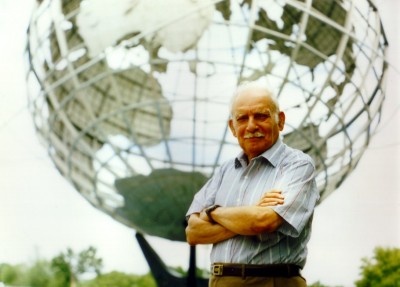 |
|
- SOURCE: Photographs presented
courtesy Glen Mordecai collection (unless otherwise indicated)
and are
- © Copyright 2005
Glen Mordecai, All Rights Reserved
|